【Kubernetes】k8s 的安全管理详细说明【role 赋权和 clusterrole 赋权详细配置说明
[](()token 验证 &&kubeconfig 验证
====================================================================================
内容过多,分开发布,token 验证 &&kubeconfig 验证去这篇博客:
[【Kubernetes】k8s 的安全管理详细说明【k8s 框架说明、token 验证和 kubeconfig 验证详细说明】](()
[](()授权
=================================================================
[](()了解 authorization-mode 授权模式
配置文件:
/etc/kubernetes/manifests/kube-apiserver.yaml
这个里面配置授权规则,大概在 20 行,规则有如下几项
修改规则以后需要重启服务生效:systemctl restart kubelet
[root@master sefe]# cat -n /etc/kubernetes/manifests/kube-apiserver.yaml| egrep mode
20 - --authorization-mode=Node,RBAC
[root@master sefe]#
--authorization-mode=Node,RBAC #默认
--authorization-mode=AlwaysAllow #允许所有请求,无论是否给权限,都能访问
--authorization-mode=AlwaysDeny #拒绝所有请求,无论是否给权限,都不允许访问【不影响 admin 文件的权限/etc/kubernetes/admin.conf】
--authorization-mode=ABAC
Attribute-Based Access Control #不够灵活被放弃使用
--authorization-mode=RBAC #这个最常用,或者说一般情况都使用这个
Role Based Access Control
--authorization-mode=Node
Node 授权器主要用于各个 node 上的 kubelet 访问 apiserver 时使用的,其他一般均由 RBAC 授权器来授权
[](()AlwaysAllow&&AlwaysDeny
这个比较直观,就是允许全部和拒绝全部
我这用一个允许全部做测试
现在有授权,先删除授权
[root@master sefe]# kubectl get clusterrolebindings.rbac.authorization.k8s.io test1
NAME ROLE AGE
test1 ClusterRole/cluster-admin 28m
[root@master sefe]# kubectl delete clusterrolebindings.rbac.authorization.k8s.io test1
clusterrolebinding.rbac.authorization.k8s.io "test1" deleted
[root@master sefe]#
我现在用的是 kubeconfig 文件继续做测试,先去看看我上面的 kubeconfig 验证,否则这看不懂啊
[root@master sefe]# ls
ca.crt ccx.crt ccx.csr ccx.key csr.yaml kc1
[root@master sefe]#
[root@master sefe]# kubectl --kubeconfig=kc1 get pods
Error from server (Forbidden): pods is forbidden: User "ccx" cannot list resource "pods" in API group "" in the namespace "default"
[root@master sefe]#
配置文件
修改为允许,然后重启服务
[root@master sefe]# vi /etc/kubernetes/manifests/kube-apiserver.yaml
[root@master sefe]# cat -n /etc/kubernetes/manifests/kube-apiserver.yaml| egrep mode
20 #- --authorization-mode=Node,RBAC
21 --authorization-mode=AlwaysAllow
[root@master sefe]#
[root@master sefe]# !sys
systemctl restart kubelet
[root@master sefe]#
[root@master ~]# systemctl restart kubelet
测试
重启以后呢,挺久时间都是会这样子的报错,是因为 apiserver 服务没起来。
[root@master ~]# systemctl restart kubelet
[root@master ~]#
[root@master ~]# kubectl get pods
The connection to the server 192.168.59.142:6443 was refused - did you specify the right host or port?
[root@master ~]#
api 状态久久不能 up,就离谱。
[root@master kubernetes]# docker ps -a | grep api
525821586ed5 4d217480042e "kube-apiserver --ad…" 15 hours ago Exited (137) 7 minutes ago k8s_kube-apiserver_kube-apiserver-master_kube-system_654a890f23facb6552042e41f67f4aef_1
6b64a8bfc748 registry.aliyuncs.com/google_containers/pause:3.4.1 "/pause" 15 hours ago Up 15 hours k8s_POD_kube-apiserver-master_kube-system_654a890f23facb6552042e41f67f4aef_0
[root@master kubernetes]#
做不了测试咯,我改了以后,集群就出问题了,api 一直起不来不说,kubelet 状态还一直报下面错误,messages 看到的一样,没找到原因,算了,不搞了,反正只要知道这个东西就行,平常也不建议用全放开或全拒绝。
[root@master ~]# systemctl status kubelet
● kubelet.service - kubelet: The Kubernetes Node Agent
Loaded: loaded (/usr/lib/systemd/system/kubelet.service; enabled; vendor preset: disabled)
Drop-In: /usr/lib/systemd/system/kubelet.service.d
└─10-kubeadm.conf
Active: active (running) since Thu 2021-11-04 09:55:26 CST; 55s ago
Docs: https://kubernetes.io/docs/
Main PID: 29495 (kubelet)
Tasks: 45
Memory: 64.8M
CGroup: /system.slice/kubelet.service
├─29495 /usr/bin/kubelet --bootstrap-kubeconfig=/etc/kubernetes/bootstrap-kubelet.conf --kubeconfig=/etc/kubernetes/kubelet.conf --config=/var/lib/kubelet/config.yaml --network-plugin=cni --pod-infra-container-image=regi...
└─30592 /opt/cni/bin/calico
Nov 04 09:56:19 master kubelet[29495]: I1104 09:56:19.238570 29495 kubelet.go:461] "Kubelet nodes not sync"
Nov 04 09:56:19 master kubelet[29495]: I1104 09:56:19.250440 29495 kubelet.go:461] "Kubelet nodes not sync"
Nov 04 09:56:19 master kubelet[29495]: I1104 09:56:19.394574 29495 kubelet.go:461] "Kubelet nodes not sync"
Nov 04 09:56:19 master kubelet[29495]: I1104 09:56:19.809471 29495 kubelet.go:461] "Kubelet nodes not sync"
Nov 04 09:56:20 master kubelet[29495]: I1104 09:56:20.206978 29495 kubelet.go:461] "Kubelet nodes not sync"
Nov 04 09:56:20 master kubelet[29495]: I1104 09:56:20.237387 29495 kubelet.go:461] "Kubelet nodes not sync"
Nov 04 09:56:20 master kubelet[29495]: I1104 09:56:20.250606 29495 kubelet.go:461] "Kubelet nodes not sync"
Nov 04 09:56:20 master kubelet[29495]: I1104 09:56:20.395295 29495 kubelet.go:461] "Kubelet nodes not sync"
Nov 04 09:56:20 master kubelet[29495]: E1104 09:56:20.501094 29495 controller.go:144] failed to ensure lease exists, will retry in 7s, error: Get "https://192.168.59.142:6443/apis/coordination.k8s.io/v1/namespace...onnection refused
Nov 04 09:56:20 master kubelet[29495]: I1104 09:56:20.809833 29495 kubelet.go:461] "Kubelet nodes not sync"
Hint: Some lines were ellipsized, use -l to show in full.
[root@master ~]#
这里面看到的报错和上面一样
[root@master ~]# tail -f /var/log/messages
[](()RBAC 模式说明【重要】
感兴趣的可以去看看官网介绍:
[RBAC](()
[](()查看 admin 权限
[root@master ~]# kubectl describe clusterrole admin
Name: admin
Labels: kubernetes.io/bootstrapping=rbac-defaults
Annotations: rbac.authorization.kubernetes.io/autoupdate: true
PolicyRule:
Resources Non-Resource URLs Resource Names Verbs
rolebindings.rbac.authorization.k8s.io [] [] [create delete deletecollection get list patch update watch]
roles.rbac.authorization.k8s.io [] [] [create delete deletecollection get list patch update watch]
configmaps [] [] [create delete deletecollection patch update get list watch]
endpoints [] [] [create delete deletecollection patch update get list watch]
persistentvolumeclaims [] [] [create delete deletecollection patch update get list watch]
pods [] [] [create delete deletecollection patch update get list watch]
replicationcontrollers/scale [] [] [create delete deletecollection patch update get list watch]
replicationcontrollers [] [] [create delete deletecollection patch update get list watch]
services [] [] [create delete deletecollection patch update get list watch]
daemonsets.apps [] [] [create delete deletecollection patch update get list watch]
deployments.apps/scale [] [] [create delete deletecollection patch update get list watch]
deployments.apps [] [] [create delete deletecollection patch update get list watch]
replicasets.apps/scale [] [] [create delete deletecollection patch update get list watch]
replicasets.apps [] [] [create delete deletecollection patch update get list watch]
statefulsets.apps/scale [] [] [create delete deletecollection patch update get list watch]
statefulsets.apps [] [] [create delete deletecollection patch update get list watch]
horizontalpodautoscalers.autoscaling [] [] [create delete deletecollection patch update get list watch]
cronjobs.batch [] [] [create delete deletecollection patch update get list watch]
jobs.batch [] [] [create delete deletecollection patch update get list watch]
daemonsets.extensions [] [] [create delete deletecollection patch update get list watch]
deployments.extensions/scale [] [] [create delete deletecollection patch update get list watch]
deployments.extensions [] [] [create delete deletecollection patch update get list watch]
ingresses.extensions [] [] [create delete deletecollection patch update get list watch]
networkpolicies.extensions [] [] [create delete deletecollection patch update get list watch]
replicasets.extensions/scale [] [] [create delete deletecollection patch update get list watch]
replicasets.extensions [] [] [create delete deletecollection patch update get list watch]
replicationcontrollers.extensions/scale [] [] [create delete deletecollection patch update get list watch]
ingresses.networking.k8s.io [] [] [create delete deletecollection patch update get list watch]
networkpolicies.networking.k8s.io [] [] [create delete deletecollection patch update get list watch]
poddisruptionbudgets.policy [] [] [create delete deletecollection patch update get list watch]
deployments.apps/rollback [] [] [create delete deletecollection patch update]
deployments.extensions/rollback [] [] [create delete deletecollection patch update]
localsubjectaccessreviews.authorization.k8s.io [] [] [create]
pods/attach [] [] [get list watch create delete deletecollection patch update]
pods/exec [] [] [get list watch create delete deletecollection patch update]
pods/portforward [] [] [get list watch create delete deletecollection patch update]
pods/proxy [] [] [get list watch create delete deletecollection patch update]
secrets [] [] [get list watch create delete deletecollection patch update]
services/proxy [] [] [get list watch create delete deletecollection patch update]
bindings [] [] [get list watch]
events [] [] [get list watch]
limitranges [] [] [get list watch]
namespaces/status [] [] [get list watch]
namespaces [] [] [get list watch]
persistentvolumeclaims/status [] [] [get list watch]
pods/log [] [] [get list watch]
pods/status [] [] [get list watch]
replicationcontrollers/status [] [] [get list watch]
resourcequotas/status [] [] [get list watch]
resourcequotas [] [] [get list watch]
services/status [] [] [get list watch]
controllerrevisions.apps [] [] [get list watch]
daemonsets.apps/status [] [] [get list watch]
deployments.apps/status [] [] [get list watch]
replicasets.apps/status [] [] [get list watch]
statefulsets.apps/status [] [] [get list watch]
horizontalpodautoscalers.autoscaling/status [] [] [get list watch]
cronjobs.batch/status [] [] [get list watch]
jobs.batch/status [] [] [get list watch]
daemonsets.extensions/status [] [] [get list watch]
deployments.extensions/status [] [] [get list watch]
ingresses.extensions/status [] [] [get list watch]
replicasets.extensions/status [] [] [get list watch]
nodes.metrics.k8s.io [] [] [get list watch]
pods.metrics.k8s.io [] [] [get list watch]
ingresses.networking.k8s.io/status [] [] [get list watch]
poddisruptionbudgets.policy/status [] [] [get list watch]
serviceaccounts [] [] [impersonate create delete deletecollection patch update get list watch]
[root@master ~]#
[](()基本概念
RBAC(Role-Based Access Control,基于角色的访问控制),允许通过 Kubernetes API 动态配置策略。
在 k8s v1.5 中引入,在 v1.6 版本时升级为 Beta 版本,并成为 kubeadm 安装方式下的默认选项,相对于其他访问控制方式,新的 RBAC 具有如下优势:
对集群中的资源和非资源权限均有完整的覆盖
整个 RBAC 完全由几个 API 对象完成,同其他 API 对象一样,可以用 kubectl 或 API 进行操作
可以在运行时进行调整,无需重启 API Server
要使用 RBAC 授权模式,需要在 API Server 的启动参数中加上–authorization-mode=RBAC
[](()原理
流程图如下【下面是对这个流程图的拆解说明】

角色
一个角色就是一组权限的集合,这里的权限都是许可形式的,不存在拒绝的规则。
,
角色只能对命名空间内的资源进行授权
Role:授权特定命名空间的访问权限【 在一个命名空间中,可以用角色来定义一个角色】ClusterRole:授权所有命名空间的访问权限【如果是集群级别的,就需要使用 ClusterRole 了。】角色绑定
RoleBinding:将角色绑定到主体(即 subject)【对应角色的 Role】
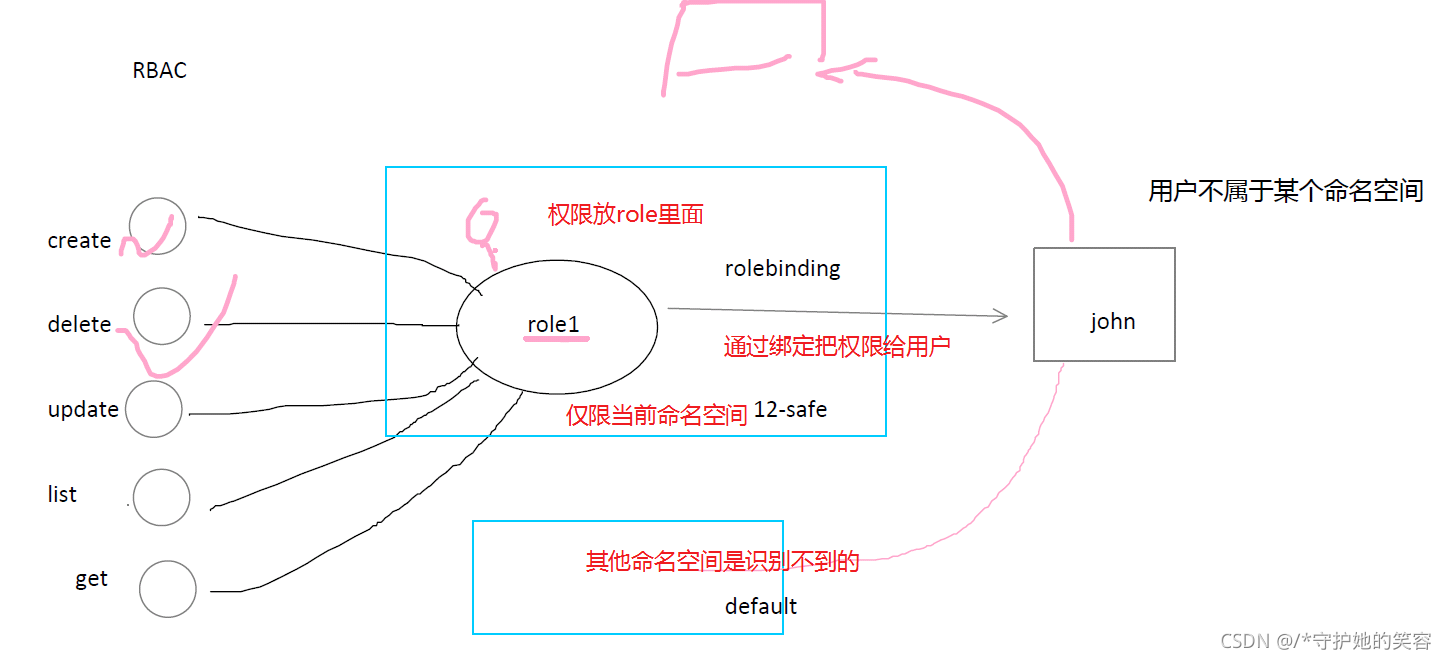
ClusterRoleBinding:将集群角色绑定到主体【对应角色的 ClusterRole】
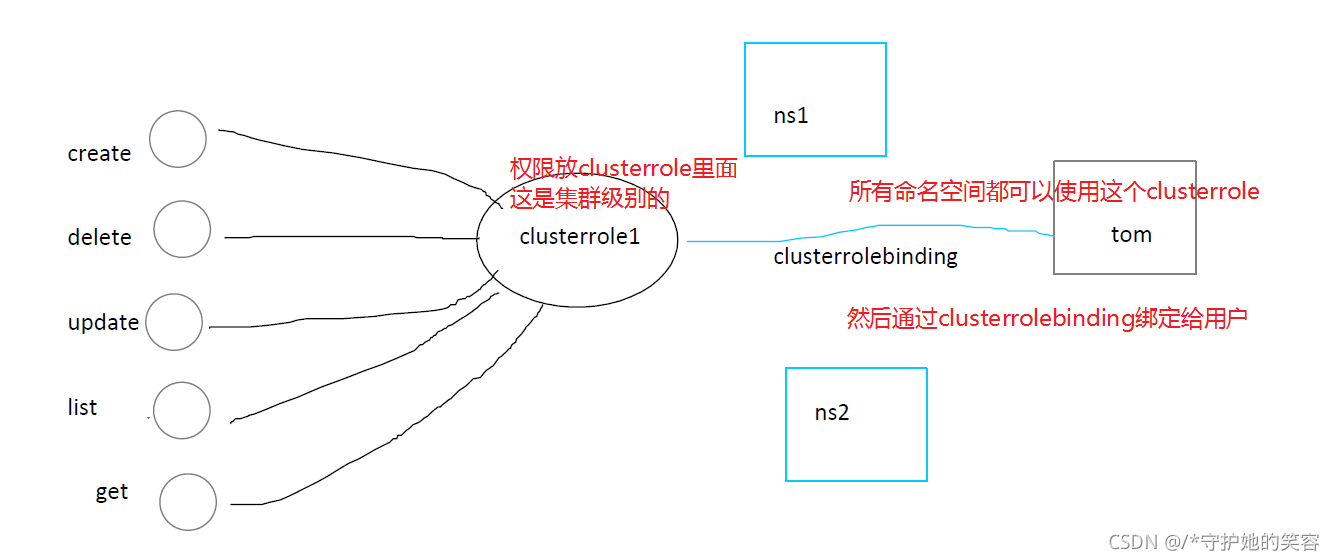
主体(subject)
User:用户Group:用户组ServiceAccount:服务账号用户或者用户组,服务账号,与具备某些权限的角色绑定,然后将该角色的权限继承过来,这一点类似阿里云的 ram 授权。这里需要注意 定义的角色是 Role 作用域只能在指定的名称空间下有效,如果是 ClusterRole 可作用于所有名称空间下。
Rolebinding 和 Role 对应,ClusterRoleBinding 和 ClusterRole 对应。
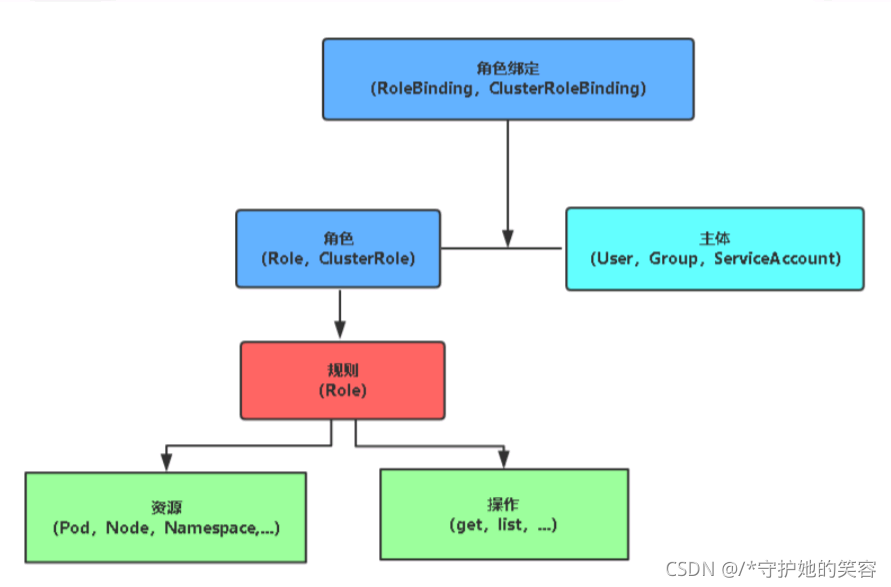
[](()ClusterRole 和 Role 的参数值说明
1、apiGroups 可配置参数
这个很重要,是父子级的关系【kubectl api-versions 可以查看】【一般有 2 种格式 /xx 和 xx/yy】
“”,“apps”, “autoscaling”, “batch”
2、resources 可配置参数
“services”, “endpoints”,“pods”,“secrets”,“configmaps”,“crontabs”,“deployments”,“jobs”,“nodes”,“rolebindings”,“clusterroles”,“daemonsets”,“replicasets”,“statefulsets”,“horizontalpodautoscalers”,“replicationcontrollers”,“cronjobs”
3、verbs 可配置参数
“get”,“list”,“watch”, “create”,“update”, “patch”, “delete”,“exec”
4、apiGroups 和 resources 对应关系
apiGroups: [""] # 空字符串""表明使用 core API group
resources: ["pods","pods/log","pods/exec", "pods/attach", "pods/status", "events", "replicationcontrollers", "services", "configmaps", "persistentvolumeclaims"]
apiGroups: [ "apps"]
resources: ["deployments", "daemonsets", "statefulsets","replicasets"]
[](()role 测试说明
[](()创建一个 role
除了我下面的方法以外,还可以使用这种方式写 role 文件
kind: Role
apiVersion: rbac.authorization.k8s.io/v1
metadata:
限定可访问的命名空间为 minio
namespace: minio
角色名称
name: role-minio-service-minio
控制 dashboard 中 命名空间模块 中的面板是否有权限查看
rules:
apiGroups: [""] # 空字符串""表明使用 core API group
#resources: ["pods","pods/log","pods/exec", "pods/attach", "pods/status", "events", "replicationcontrollers", "services", "configmaps", "persistentvolumeclaims"]
resources: ["namespaces","pods","pods/log","pods/exec", "pods/attach", "pods/status","services"]
verbs: ["get", "watch", "list", "create", "update", "patch", "delete"]
apiGroups: [ "apps"]
resources: ["deployments", "daemonsets", "statefulsets","replicasets"]
verbs: ["get", "list", "watch"]
生成 role 的配置文件
我们可以直接通过这种方式生成 yaml 文件,后面如果需要做啥操作的话,直接对 yaml 文件操作就行了
下面生成的 yaml 中,参数需要修改的,看上面 Role 参数值说明,上面中有可选参数的详细说明。
[root@master ~]# kubectl create role role1 --verb=get,list --resource=pods --dry-run=client -o yaml > role1.yaml
[root@master ~]# cat role1.yaml
apiVersion: rbac.authorization.k8s.io/v1
kind: Role
metadata:
creationTimestamp: null
name: role1
rules:
apiGroups:
""
resources:
pods
#如果需要同时存在多个参数,以下面 get 和 list 的形式存在。
verbs:
get
list
[root@master ~]#
如,我现在对 verbs 增加一个 create 权限和增加一个 node 权限
[root@master ~]# mv role1.yaml sefe/
[root@master ~]# cd sefe/
[root@master sefe]# vi role1.yaml
[root@master sefe]# cat role1.yaml
apiVersion: rbac.authorization.k8s.io/v1
kind: Role
metadata:
creationTimestamp: null
name: role1
rules:
apiGroups:
""
resources:
pods
nodes
verbs:
get
list
create
[root@master sefe]#
生成 role
后面修改后可以直接生成就会覆盖之前的权限了,不用删除了再生成。
[root@master ~]# kubectl apply -f role1.yaml
role.rbac.authorization.k8s.io/role1 created
[root@master ~]#
[root@master ~]# kubectl get role
NAME CREATED AT
role1 2021-11-05T07:34:45Z
[root@master ~]#
查看详细
可以看到这个 role 已有权限
[root@master sefe]# kubectl describe role role1
Name: role1
Labels: <none>
Annotations: <none>
PolicyRule:
Resources Non-Resource URLs Resource Names Verbs
jobs [] [] [get list create]
nodes [] [] [get list create]
pods [] [] [get list create]
[root@master sefe]#
[](()创建 rolebinding【绑定用户】
注意,用户是不属于任何命名空间的
创建 rolebinding 需要先创建一个 role 和对应的用户名哦
#下面中 rdind1 是自定义的名称
--role=指定一个 role
#user=为哪个用户授权
[root@master ~]# kubectl create rolebinding rbind1 --role=role1 --user=ccx
rolebinding.rbac.authorization.k8s.io/rbind1 created
[root@master ~]#
[root@master ~]# kubectl get rolebindings.rbac.authorization.k8s.io
NAME ROLE AGE
rbind1 Role/role1 5s
[root@master ~]#
[root@master sefe]# kubectl describe rolebindings.rbac.authorization.k8s.io rbind1
Name: rbind1
Labels: <none>
Annotations: <none>
Role:
Kind: Role
Name: role1
Subjects:
Kind Name Namespace
User ccx
[root@master sefe]#
创建 ServiceAccount 和 Role 的绑定
我上面是用命令的形式实现的嘛,这是我在网上看到的其他资料,是用文件的形式实现,感兴趣的小伙伴可以用这种方法一试。。。。
[root@app01 k8s-user]# vim role-bind-minio-service-minio.yaml
kind: RoleBinding
apiVersion: rbac.authorization.k8s.io/v1
metadata:
#namespace: minio
name: role-bind-minio-service-monio #自定义名称
subjects:
kind: ServiceAccount
#namespace: minio
name: username # 为哪个用户授权
roleRef:
kind: Role
角色名称
name: rolename#role 的名称
apiGroup: rbac.authorization.k8s.io
[root@app01 k8s-user]# kubectl apply -f role-bind-minio-service-minio.yaml
rolebinding.rbac.authorization.k8s.io/role-bind-minio-service-monio created
[root@app01 k8s-user]# kubectl get rolebinding -n minio -owide
NAME AGE ROLE USERS GROUPS SERVICEACCOUNTS
role-bind-minio-service-monio 29s Role/role-minio-service-minio minio/service-minio
[root@app01 k8s-user]#
[](()测试
注意,我上面已经授权了 ccx 用户和配置文件【看 kubeconfig 验证中的操作流程】,所以我这直接用一个集群外的主机来做测试【注意,这个集群 ip 我在 kubeconfig 验证中已经做好所有配置了,所以我可以直接使用】
查询测试
上面我们已经对 ccx 用户授权 pod 权限了,可是直接使用会发现依然报错
[root@master2 ~]# kubectl --kubeconfig=kc1 get pods
Error from server (Forbidden): pods is forbidden: User "ccx" cannot list resource "pods" in API group "" in the namespace "default"
#是因为前面说明 role 是对命 《一线大厂 Java 面试题解析+后端开发学习笔记+最新架构讲解视频+实战项目源码讲义》无偿开源 威信搜索公众号【编程进阶路】 名空间生效的【上面我们在 safe 命名空间】
#所以我们需要指定命名空间
[root@master2 ~]# kubectl --kubeconfig=kc1 get pods -n safe
No resources found in safe namespace.
[root@master2 ~]#
当然,只要有这个 kc1 配置文件的,在哪执行都行【当前在集群 master 上】
[root@master sefe]# ls
ca.crt ccx.crt ccx.csr ccx.key csr.yaml kc1 role1.yaml
[root@master sefe]# kubectl --kubeconfig=kc1 get pods -n safe
No resources found in safe namespace.
[root@master sefe]#
创建 pod 测试
为了更能方便看出这个效果,所以我还在集群外的主机上操作吧。
#拷贝一个 pod 文件
[root@master sefe]# scp ../pod1.yaml 192.168.59.151:~
root@192.168.59.151's password:
pod1.yaml 100% 431 424.6KB/s 00:00
[root@master sefe]#
回到测试机上创建一个 pod,是可以正常创建成功的
[root@master2 ~]# kubectl --kubeconfig=kc1 get nodes -n safe
^[[AError from server (Forbidden): nodes is forbidden: User "ccx" cannot list resource "nodes" in API group "" at the cluster scope
[root@master2 ~]# kubectl --kubeconfig=kc1 get pods -n safe
No resources found in safe namespace.
[root@master2 ~]#
[root@master2 ~]# export KUBECONFIG=kc1
[root@master2 ~]#
[root@master2 ~]# kubectl apply -f pod1.yaml -n safe
pod/pod1 created
[root@master2 ~]#
[root@master2 ~]# kubectl get pods -n safe
NAME READY STATUS RESTARTS AGE
pod1 1/1 Running 0 8s
[root@master2 ~]#
如果不指定命名空间的话就是创建在本地了,但是本地是没有镜像的,所以状态会一直为 pending
[root@master2 ~]# kubectl apply -f pod1.yaml
pod/pod1 created
[root@master2 ~]# kubectl get pods
NAME READY STATUS RESTARTS AGE
pod1 0/1 Pending 0 3s
[root@master2 ~]#
现在回到集群 master 上,可以看到这个 pod 被创建成功的
[root@master sefe]# kubectl get pods
NAME READY STATUS RESTARTS AGE
pod1 1/1 Running 0 32s
[root@master sefe]#
删除 pod 测试
是删除不了的哈,因为这个没有给 delete 权限
[root@master2 ~]# kubectl delete -f pod1.yaml -n safe
Error from server (Forbidden): error when deleting "pod1.yaml": pods "pod1" is forbidden: User "ccx" cannot delete resource "pods" in API group "" in the namespace "safe"
[root@master2 ~]#
没关系呀,我们去给 delete 权限就是了
#集群 master 节点
[root@master sefe]# cat role1.yaml
apiVersion: rbac.authorization.k8s.io/v1
kind: Role
metadata:
creationTimestamp: null
name: role1
rules:
apiGroups:
""
resources:
nodes
pods
jobs
verbs:
get
list
create
delete
[root@master sefe]# kubectl apply -f role1.yaml
role.rbac.authorization.k8s.io/role1 configured
[root@master sefe]#
#测试节点
[root@master2 ~]# kubectl delete -f pod1.yaml -n safe
pod "pod1" deleted
[root@master2 ~]#
[root@master2 ~]# kubectl get pods -n safe
No resources found in safe namespace.
[root@master2 ~]#
[](()Error from server (Forbidden)报错处理
报错内容如下
[root@master2 ~]# kubectl --kubeconfig=kc1 get pods -n safe
Error from server (Forbidden): pods is forbidden: User "ccx" cannot list resource "pods" in API group "" in the namespace "safe"
[root@master2 ~]#
之前问讲师
可能讲师也很懵吧,一直没给我解答,最后自己琢磨出来了
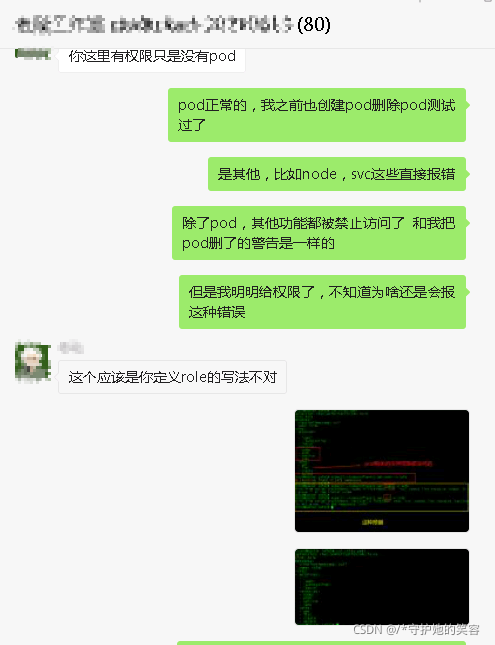
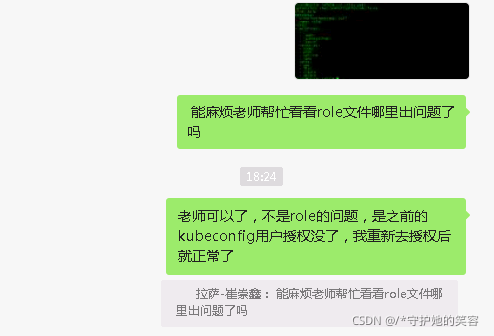
这种情况并不是 role 的配置文件问题,而是因为 kc1 中 ccx 这个用户的授权出问题了,至于排查方法,去看 kubeconfig 配置那篇文章,从开始一步步跟着排查【重点看 csr 和授权这样子】
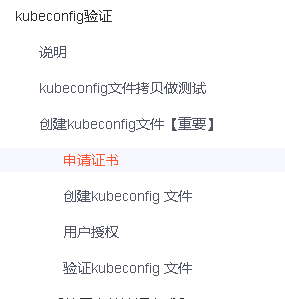
总结:上面 config 授权好像和这没关系,如果用之前授权的方式给用户授权的话,好像 role 并没有生效了【本来 role 就是授权用的,上面的方式直接给了 admin 权限了,覆盖 role 了 】,所以,我上面的处理方法好像是错的,但是讲师也没有纠正我,所以,讲师也并没有很负责吧,几千块钱的培训费花的感觉并不值得,反正 role 这个问题,如果遇到部分权限能用,部分不能用,还是排查 role 相关的知识吧,我上面这个办法还是别采取了【所以,role 着知识我觉得上面配置流程是没有错的,可能是我集群环境试验太多东西,啥配置被我搞乱罢了,后面有时间打新集群了再回过头来重新做一遍 role 相关的试验吧】
[](()role 的 resources 分开赋权
其实 apiGroups 是一个独立模块,一个 apiGroups 定义一个功能,所以如果我们想对不同的组建定义不同的功能,我们就可以添加足够多的 apiGroups 分开写就是了
比如现在我们想对 pod 和 deployment 分开赋权,那么我们就可以像下面这么写【用 2 个 apiGroups 即可】
像这种写法就可以创建 deployment 和管理副本数了。
[root@master sefe]# cat role2.yaml
apiVersion: rbac.authorization.k8s.io/v1
kind: Role
metadata:
creationTimestamp: null
name: role1
rules:
apiGroups:
""
resources:
pods
verbs:
get
list
create
delete
apiGroups:
"apps"
resources:
deployments
deployments/scale
verbs:
get
list
create
delete
patch
[root@master sefe]#
role 的使用到此就完了,后面可以多测试哦
现在我们删除这 2 样,后面进行 ClusterRole 的测试吧
[root@master sefe]# kubectl delete -f role1.yaml
role.rbac.authorization.k8s.io "role1" deleted
[root@master sefe]# kubectl delete rolebindings.rbac.authorization.k8s.io rbind1
rolebinding.rbac.authorization.k8s.io "rbind1" deleted
[root@master sefe]#
[](()clusterrole 测试说明
[](()创建一个 clusterrole
除了我下面的方法外,还可以使用这种方式
kind: ClusterRole
apiVersion: rbac.authorization.k8s.io/v1
metadata:
鉴于 ClusterRole 是集群范围对象,所以这里不需要定义"namespace"字段
角色名称
name: cluster-role-paas-basic-service-minio
控制 dashboard 中 命名空间模块 中的面板是否有权限查看
rules:
apiGroups: ["rbac.authorization.k8s.io",""] # 空字符串""表明使用 core API group
#resources: ["pods","pods/log","pods/exec", "pods/attach", "pods/status", "events", "replicationcontrollers", "services", "configmaps", "persistentvolumeclaims"]
resources: ["pods","pods/log","pods/exec", "pods/attach", "pods/status","services"]
verbs: ["get", "watch", "list", "create", "update", "patch", "delete"]
apiGroups: [ "apps"]
resources: ["namespaces","deployments", "daemonsets", "statefulsets"]
verbs: ["get", "list", "watch"]
注:这个其实好 role 是一样的配置方法,唯一区别就是,yaml 文件中 kind 的 Role 需要改为 ClusterRole
生成 clusterrole 的配置文件
我们可以直接通过这种方式生成 yaml 文件,后面如果需要做啥操作的话,直接对 yaml 文件操作就行了
下面生成的 yaml 中,参数需要修改的,看上面 ClusterRole 参数值说明,上面中有可选参数的详细说明。
[root@master sefe]# kubectl create clusterrole crole1 --verb=get,create,delete --resource=deploy,pod,svc --dry-run=client -o yaml > crole1.yaml
[root@master sefe]# cat crole1.yaml
apiVersion: rbac.authorization.k8s.io/v1
kind: ClusterRole
metadata:
creationTimestamp: null
name: crole1
rules:
apiGroups:
""
resources:
pods
services
verbs:
get
create
delete
apiGroups:
apps
resources:
deployments
verbs:
get
create
delete
[root@master sefe]#
生成 role
后面修改后可以直接生成就会覆盖之前的权限了,不用删除了再生成。
[root@master sefe]# kubectl apply -f crole1.yaml
clusterrole.rbac.authorization.k8s.io/crole1 created
[root@master sefe]#
[root@master sefe]# kubectl get clusterrole crole1
NAME CREATED AT
crole1 2021-11-05T10:09:04Z
[root@master sefe]#
查看详细
[root@master sefe]# kubectl describe clusterrole crole1
Name: crole1
Labels: <none>
Annotations: <none>
PolicyRule:
Resources Non-Resource URLs Resource Names Verbs
pods [] [] [get create delete]
services [] [] [get create delete]
deployments.apps [] [] [get create delete]
[](()创建 cluserrolebinding【绑定用户】
注意,这是所有命名空间都生效的
创建 cluserrolebinding 需要先创建一个 role 和对应的用户名哦
#下面中 rdind1 是自定义的名称
--role=指定一个 role
#user=为哪个用户授权
[root@master ~]#
[root@master sefe]# kubectl create clusterrolebinding cbind1 --clusterrole=crole1 --user=ccx
clusterrolebinding.rbac.authorization.k8s.io/cbind1 created
[root@master sefe]#
[root@master sefe]# kubectl get clusterrolebindings.rbac.authorization.k8s.io cbind1
NAME ROLE AGE
cbind1 ClusterRole/crole1 16s
[root@master sefe]#
前面说过,这是对所有命名空间都生效的,所以我们随便查看几个命名都会发现有这个 cluser 的存在
[root@master sefe]# kubectl get clusterrolebindings.rbac.authorization.k8s.io -n default cbind1
NAME ROLE AGE
cbind1 ClusterRole/crole1 28s
[root@master sefe]#
[root@master sefe]# kubectl get clusterrolebindings.rbac.authorization.k8s.io -n ds cbind1
NAME ROLE AGE
cbind1 ClusterRole/crole1 35s
[root@master sefe]#
查看详情
[root@master sefe]# kubectl describe clusterrolebindings.rbac.authorization.k8s.io cbind1
Name: cbind1
Labels: <none>
Annotations: <none>
Role:
Kind: ClusterRole











评论